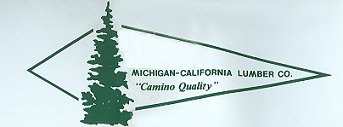 |
Pino Grande |
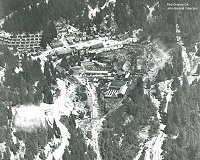 aerial view |
Pino Grande was originally a lumber camp of the American River Land & Lumber Co. Logs were transported from here to a point high above the South Fork of the American River by narrow gauge railroad to a log chute. From there they were floated down the river to a mill in Folsom.
In 1901, the El Dorado Lumber Co purchased the ARLLCo. They built a planing mill and headquarters in Camino, a narrow gauge railroad from Camino to a point directly across the canyon from the chute and a cable way across the canyon to connect the two. The machinery from the Folsom mill was moved to Pino Grande to form a new rough cut mill. Lumber from this mill was then moved via the railroads and cable to Camino.
Operations continued like this through several corporate changes into the late 1940s when the south tower of the cable burnt and log hauling was shifted to trucks. Shortly the railroad and Pino Grande mill were scrapped with the Camino mill being expanded to handle all the cutting.
After the South Cable tower burnt down in 1949, another way was found to get the cut lumber off the Georgetown Divide, so the county built Rock Creek Road from above Chile Bar on Hwy 193, half way up the canyon wall, out to Mosquito, to tie into Mosquito Rd. which was a single lane dirt road that ran out to Pino Grande. It was widened and built for heavy truck traffic, to haul the green lumber to Camino, to the planing mill and box factory, and their shipping on the CPLT RR.
After the new sawmill was built at Camino, the scrappers were sent into Pino Grande, to deal with 50 years of logging equipment. We know what happened to all of the heavy iron and steel that collected for 50 years...
After the scrappers scrapped all of the heavy metal in the area of Pino, and the logging railroad, what was left was the naked mill structure and the town and shops. With nobody now living and working there, and it sitting so far out in the forest by itself, Michigan-Cal decided to finish razing the site to stop squatters from moving onto Michigan-Cal's private land.
Mr Jones' father was sent in, in the winter, while Pino was still covered with snow, to raze the site. Him and a crew went in and burned down all standing structures. Mr Jones took private pictures of his work that day.
So here are the photos showing the mill's fate.
Lee Rogers
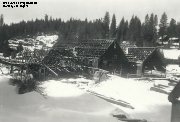
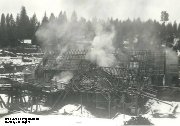
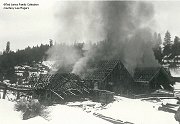
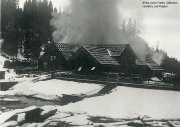
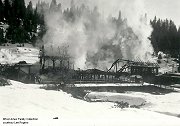
There are many remains left for the history or railroad enthusiast to explore. A trip to Pino Grande in October of 2011 was made to document its remains. Below you'll find the numbered images and a map of the mill complex. The map has been marked with numbers to match and arrows to indicate the direction of view in each photo. Tour starts at bottom left and continues clockwise. Enjoy.

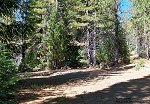
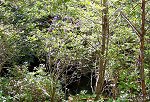
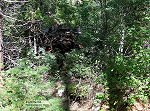
6. 5. 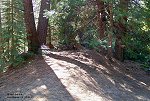 4. 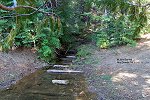 3. 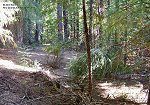 2. 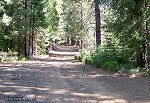 |
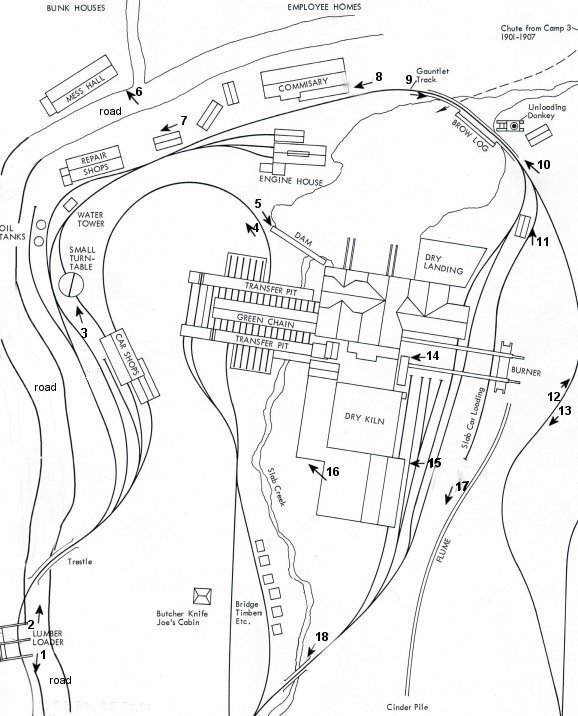 |
11.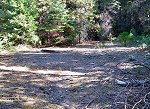 12. 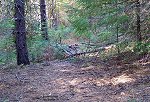 13. 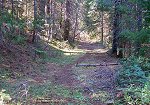 14. 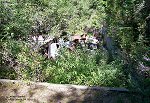 15. 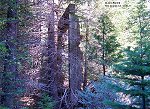 |
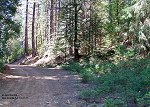
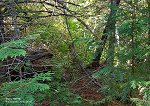
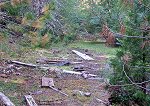
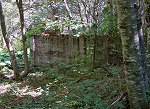
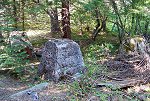 |
 |
 |
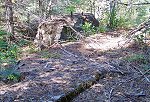 |
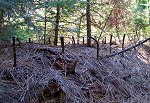 |
1.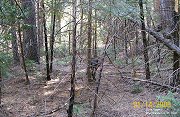 |
2. |
3.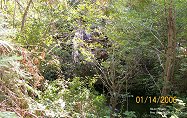 |
4.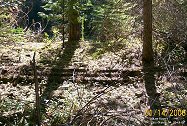 |
5.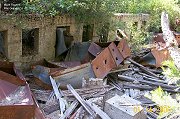 |
6.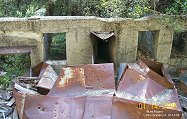 |
1. This is the car shops remains. 2. Nearby is the stone turntable. 3. Site of the brow log where the loads were dumped from the log cars into the pond. 4. Here is the remains for a boiler mount. 5.-6. Views of the dry kiln heater remnants.
You Have to Remember, Everything on the Mill and Mill site WAS BUILT LEVEL WITH THE 2nd STORY....CLEAR ACROSS SLAB CREEK....Almost to the Car Shops... 10-30 ft ABOVE Slab Creek...
And the Base of the Fill, the Car Shops and everything sat on were Big Logs... Cribbed up... They have Just Rotted away in the Last 70 yrs....
Another Tidbit of Information...I counted about 5 Transfer Pits, to Move Loaded Lumber Cars around the Mill, mostly around the Dry Kilns...
2 Longest were on each side of the Green Chain...The Mill Was 3 Stories Tall... The Top North-South Part, Filers Loft, 2nd Floor... Main Mill Floor...
Saws, Powered Rolls, Gang Saws, Transfer Tables... Lower Level... Steam Engines, Line Shafts, Conveyor Troughts to Gather Saw Dust and Slash...
But on the Flat Ground on the South side of the Creek, there is a Large Concrete Foundation, that is Part of the Dry Kilns...On the East Side...
There were Transfer Pits to Move Loaded Lumber Cars, Rolling on Steel Rails , on Both Ends of the Dry Kilns and The Big Covered Loading Shed, for
shipping Dry Loads to Camino...The Green Lumber, came Down the North Side of the Creek...
The Dry Kilns Used a Unique System... A Large Steam Powered Fan, Mounted on the North side of that Big Foundation Pumped Air, Into a Large Sheet Metal,
Manafold that Ran in the Bottom of the Big Foundation, Down it's Length... There were Off shoots that Ran to Each Cell, in the Dry Kiln, Under Neith Each Set of Tracks, in Each Cell....
The Floor above the Foundation was Large Timbers to Provide Insulation and Rail Suppoort... Live Steam was Dumped into the Area where the Big Manifold was Moving Air.....
Heating that Cold Outside Mountain Air to Close to 200 deg... Being The Steam was Just Heating the Sheet Metal Ducts.... It was ALSO DRY HOT AIR...
The Walls of the Dry Kilns Were Also Made of 2 Chambered Terra Cotta Blocks... That gave 2 Dead Air Spaces, between the Inside and Outsides of the Dry Kilns....
The Turn Table was a Big Raised Concrete and Stone Lined Disk... The Tracks for a 2 Truck Shay are only 26 ft...
Lee Rogers

